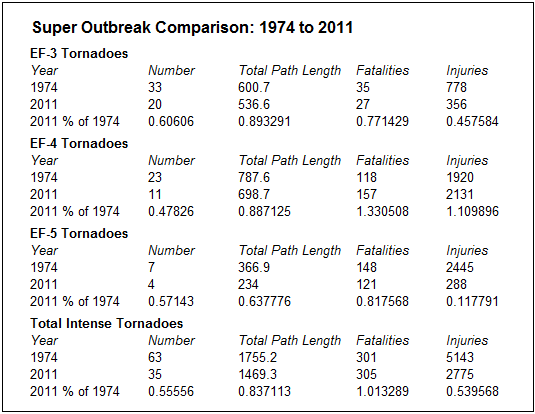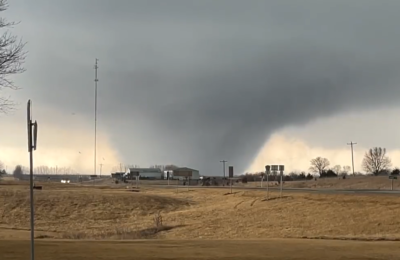This was a special guest post by Tony Lyza. Lyza joined the team in December 2012.
The major tornado outbreak of April 27, 2011 certainly goes down in the record books as one of the very worst tornado outbreaks in U.S. history. With the nickname “2011 Super Outbreak” catching on in many circles, the one-year anniversary of the 2011 event seems as appropriate a time as ever to compare 2011 to 1974.
The focus on tornado statistics often focuses on the number of tornadoes for a given category. For the purposes of comparing 1974 to 2011, I compared F3/EF-3, F4/EF-4, and F5/EF-5 tornadoes for each outbreak. These categories are generally deemed to be “intense” tornadoes. These tornadoes were more likely to not be missed in records from the 1970s than F0/EF-0 to F2/EF-2 tornadoes. In fact, if anything, tornado rating philosophies today are such that achieving intense tornado ratings is more difficult due to more stringent survey techniques.
With all that said, here is a chart of statistics for intense tornadoes from the two outbreaks:
There are several interesting items to note from this chart. First off, across the board, 2011 falls fairly far short of 1974 in terms of the number of intense tornadoes per category, with a total of only 55.6% of the intense tornadoes that the 1974 Super Outbreak had. But the 2011 outbreak featured a total path length of intense tornadoes of 83.7% that of 1974. Though the path length of EF-3 through EF-5 tornadoes in 2011 still falls a bit short of 1974, the difference is far more miniscule, with EF-3 through EF-5 tornadoes still accounting for a total of 1,469.3 miles on April 27, 2011.
When the higher fatality rate for the 2011 outbreak is factored in, there is no doubt, statistically or psychologically, that the April 27, 2011 tornado outbreak was indeed a super outbreak.
Tony Lyza is a senior meteorology major at Valparaiso University in Valparaiso, IN. His research interests are in severe storm and boundary layer processes, with a special emphasis on radar applications. He will be attending University of Alabama in Huntsville beginning in August, where he will be working as a graduate research assistant in UAH’s Severe Weather Group while pursuing a Master’s Degree in Atmospheric Science.
Want to write a guest post? Send us your idea: ustornadoes AT gmail DOT com
Tony Lyza
Latest posts by Tony Lyza (see all)
- 2014’s EF3+ tornado drought: The latest in the year on record without one - April 8, 2014
- Tornado Damage Surveys and Ratings: Why Pictures Don’t Tell the Whole Story - February 19, 2013
- Quick Update: Tornado Outbreak Likely Christmas Morning through the 26th - December 24, 2012


Guess I’m getting old. I remember the 1974 outbreak as a freshman at Virginia Tech and I chased the northern VA leftovers of the 2011 outbreak.